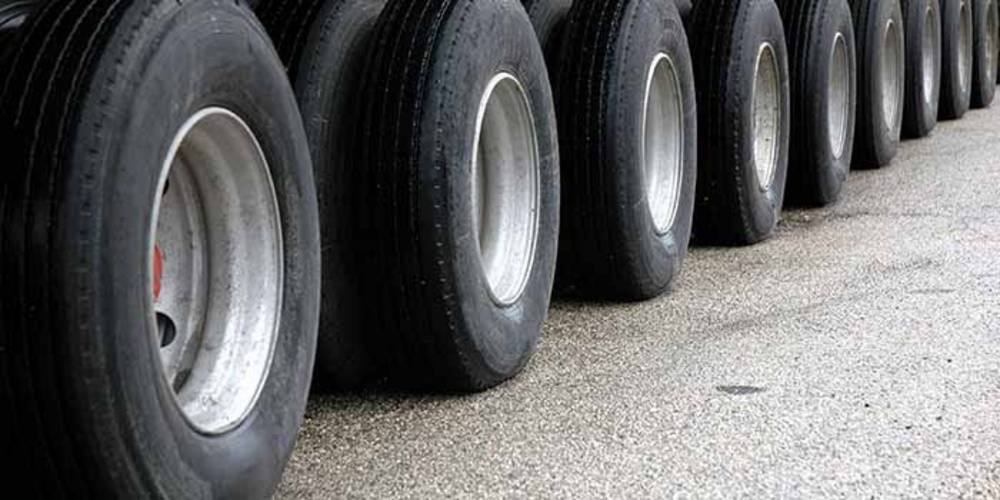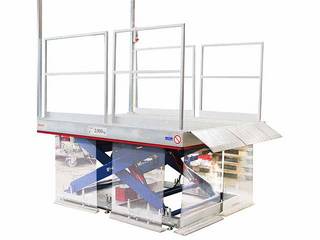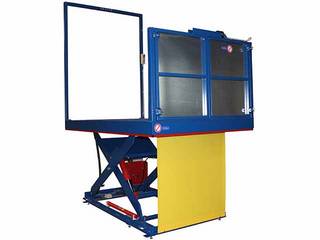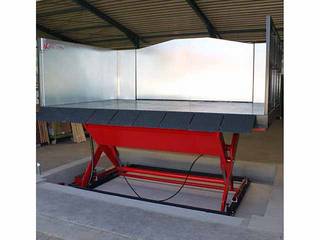The loading lift table: The loading lift table: your useful helper for warehouse material handling. It is always used when loads need to be moved from the ground onto a ramp or when a vehicle is loaded and unloaded. However, the generic term 'loading lift' covers a wide variety of configurations. For this reason we would like to present the classic applications.
The basic types
Even if no two loading lift tables are alike, there are always recurring installation situations and requirements. In this short section we will highlight three typical application examples for loading lifts. You may also find your application among them. If not, simply contact us, we will be happy to advise you personally.
Type 1 loading lift table: Unloading a vehicle
This type is used to load and unload vehicles without their own lift platform. The load for the truck or van can be loaded from a higher ramp or from the ground.
The typical equipment includes bridge plates, which are usually attached to a narrow side of the platform. They are used to bridge the gap between the platform of the lift table and the loading area of the vehicle. The loading flaps also compensate for small height differences between the lift table platform and the vehicle, which are caused by the compression and rebound of the lift table or the vehicle.
There is usually a gantry on the ramp side. This travels along on the lift table platform and, in the lowered position, serves as a fall protection from the top landing. It can be easily be passed through in the raised position. However, if the effective stroke is greater than 1,600 mm, this type of fall protection may no longer be used. In these cases, a permanently installed landing door must be provided on the ramp.
In addition to the fall protection from the top landing, the risk of falling from the lift table platform must also be eliminated. Railings are installed on both long sides of the platform for this purpose. With their height of at least 1,100 mm, they provide reliable protection for the operating personnel. Depending on whether or not the lift platform needs to be driven over in the lowered position, the platform railings are designed to be insertable, bolted on or welded on.
The barrier is another typical protection device for loading lift tables. For lift tables in outdoor areas , a corrugated wire-mesh screen, a type of chain curtain, is often used. It is installed on all accessible platform sides, i.e. when the lift table is in front of a ramp, on one narrow and both long sides.
Type 2 loading lift table: From the road onto the ramp
This type of structure is used to transfer loads from the street level to a ramp. The scissor lift table is often found where goods are handled with pallet trucks or to bridge different levels between two buildings.
The equipment of this type hardly differs from the first type. Instead of the bridge plates for vehicle unloading, there is only one electromechanically secured access door on the platform.
Type 3 loading lift table: From the vehicle to the road
Not every loading lift table stands in front of a loading ramp, some also stand on its own in the room . This type is used when a vehicle needs to be loaded or unloaded and the goods are then transported away at street level.
As this lift platform stands on its own in the room, measures must taken to prevent the operating personnel falling off the platform. To achieve this, the following configuration is used in most cases.
Bridge plates are fitted to one narrow side to bridge the gap between the lift platform and the loading area. Permanently installed platform railings are mostly attached to the three remaining sides, with an electromechanically secured platform door on one of the three sides. If the lowered loading lift table should be driven over, we install insertable platform railings that can be easily removed for this purpose. Of course, because it is standing on its own in the room, a barrier is necessary on all four sides.
More customisation options
In addition to the prescribed safety equipment, there are also a number of extras that can increase the satisfaction of using the lift in the long term. In this section we would like to show you a few options; further details can of course be discussed during a personal meeting.
Traversable version
A design that can be driven over is always a good idea if vehicles should either be able to drive directly up to the loading ramp or if vehicles have to drive across the platform. In this case, the platform is equipped with additional stiffeners and the force transmission into the pit is optimised. For the design of the lift platform in these cases, we need to know with which wheel load you want to drive over the lift table.
Hot-dip galvanised version
Our standard version when the lift platform is used outdoors. The hot-dip galvanised version has a higher abrasion resistance and better weather resistance than a painted version. This eliminates both the risk of the surface coating flaking off due to load changes and of damage through corrosion.
Foot control under a flap in the platform
A rather rarely chosen extra. Always recommended when the operation should not be immediately apparent or when the hands must remain free to fix the load.
Inspection opening
This is a small, closable opening in the platform, which is usually placed above the internal power unit. If there is a control system defect, the mains voltage can be connected directly to the motor to extend the lift table for repairs.
Replacement of older loading lift tables
We regularly receive enquiries about the replacement of an old loading lift table. Many of these old platforms have a service life of more than two decades. Unfortunately, the age of these platforms is always good for a nasty surprise during the first consultation. It used to be common practice to place only one column to hold onto on loading lift tables. The control unit of the lift table was integrated into this column. Platform railings, doors or gantries were features you would be looking in vain for. The big advantage for the customer was that there were no insertable railings to be removed in the lowered position, and the scissor lift could be driven over straightaway.
To prevent serious injuries, the safety requirements have been continuously increased over the last decades and therefore such a configuration is no longer permitted. Safety equipment such as platform railings, etc. must also be provided for replacements, and this from a fall height of half a metre.






Comments (0)
No comments found!